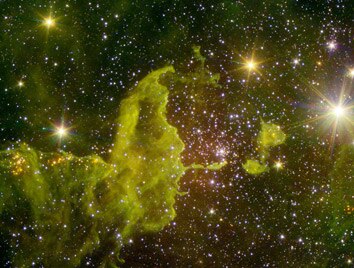Create a free profile to get unlimited access to exclusive videos, sweepstakes, and more!
A Sooty Cosmic Spider

I’m always surprised when I find a picture of a nebula I’ve never heard of before, especially when it’s big and splashy and very cool-looking, as well as scientifically really interesting.
So I got a bit of a shock when I saw this image of IC 417, aka The Spider Nebula, on NASA’s Instagram feed*:
That image is in the infrared and is a combination of observations taken using the Two Micron All Sky Survey (shown in blue, representing a wavelength of 1.2 microns), and Spitzer Space Telescope (green and red, 3.6 and 4.5 microns respectively). All these colors are well outside what the human eye can see, showing what astronomers call warm dust.
The nebula is located roughly 7,000 light-years from Earth, and quite a bit is going on in it.
The strong green glow in the image is the result of lots of PAHs, or polycyclic aromatic hydrocarbons. You can think of them as soot! They’re carbon compounds created when stars are born and when they die. In a situation like this, with puffy clouds of them, you can be pretty sure stars are forming nearby.
And they are! In more than one place, actually. In the center of the image is that large half-oval green cloud, with a sharply defined (if squiggly) edge on the right. Just to the right of it is a small knot of stars called Stock 8. That’s a newborn cluster, with stars ranging from 1 million to 5 million years in age—that’s quite a spread, indicating there were probably a couple of different waves of star birth in it. It has quite a few hot, blue, massive stars in it, mostly around 2 million years old.
The light from those stars is eating away at the edge of the nebula, their fierce ultraviolet glow eroding the gas and dust like a sandblaster. That’s why that edge of the cloud is so sharp.
The left side of the nebula is a different story. That long horizontal stream of dust looks like another “photoionization edge,” a sharply defined edge due to erosion from a bright star or stars. You might guess that very bright star just above it is the culprit; I did at first.
But it turns out it’s not. That star is actually something of a dim bulb, not nearly capable of the kind of intensity needed to erode away the dust. Remember, this is an infrared shot, where cool, red stars look pretty bright. In a visible light image, it’s hard to even see that star at all! It may be a red dwarf in the foreground, or a very distance red giant, but either way it doesn’t have the oomph needed to carve out that flat edge. The more likely star is off the top edge of the image, where we can’t see it here.
If you look at that long horizontal streak, you’ll see it’s loaded with red stars. Those are newborn stars deeply embedded in the dust, probably only 1 million years old. They are likely not physically associated with the stars in Stock 8 but are clearly part of the overall nebular complex.
So like I said, there’s a lot going on here. I think my favorite part is how different this nebula and its stars look in visible light versus infrared, and how that can reveal information about the physical nature of what you’re seeing. This is the major reason astronomers build telescopes with different capabilities, like seeing in the infrared, the radio, the ultraviolet, the gamma-ray region. All of these different energies of light tell a different part of the story, and without them we’d be missing a critical part of the plot.
* I'm on Instagram, too, if you like pictures of cute, funny, adorable goats.




























